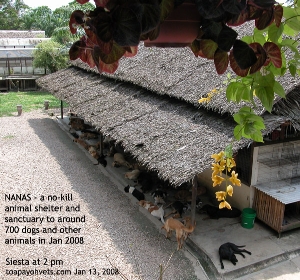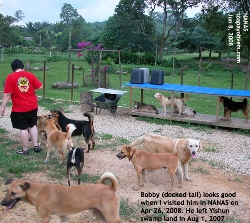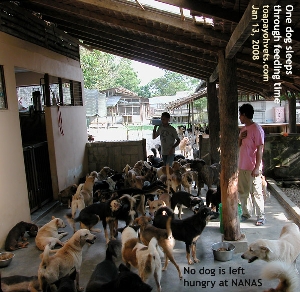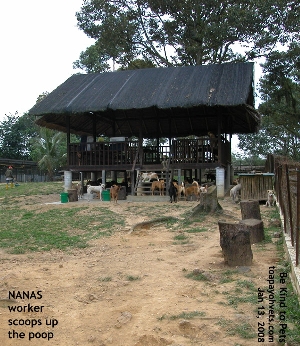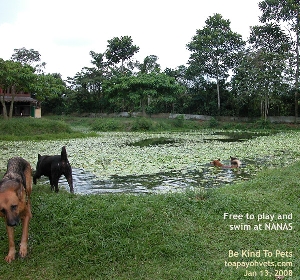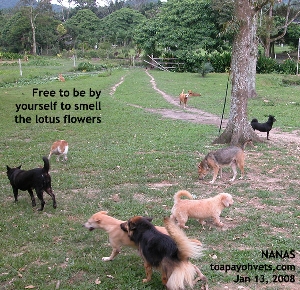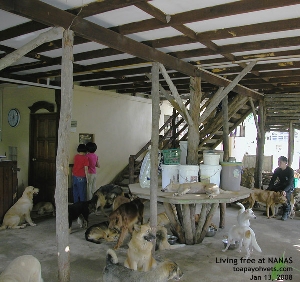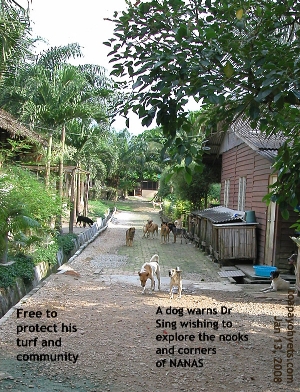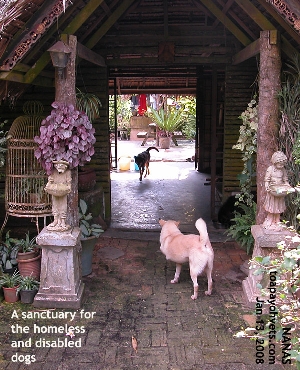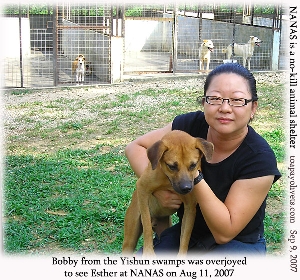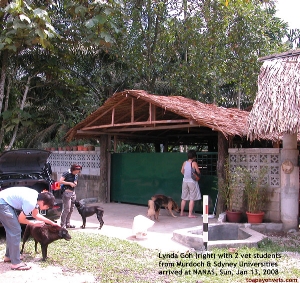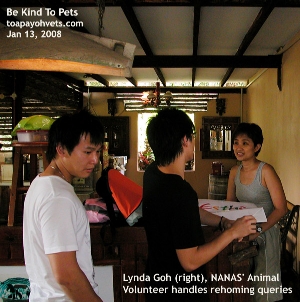"I don't know how Mr Happy initially fits in," Ms Huney replied.
"Do you think there are war zones in NANAS, equivalent to those in Afghanistan and Somalia?" I asked the slim tanned woman who loves animal, "Where groups of dogs ally and protect their piece of ground, preventing other dogs from stepping into the land by barking or biting the newcomer?"
Ms Esther Seah who had rehomed Bobby in NANAS told me that Bobby would never step into another location inside NANAS when she visited him. Bobby would just not follow her into the new turf. It was as if there was a no-go zone, a de-militarised zone as between South and North Korea.
Ms Honey
said: "Men behave worst than animals." I presume
she meant that men behave worst than animals with
so many genocides, bombings and fighting for power
and land still going on in this world.
But Ms Honey recalled: "Max will have no
restrictions going anywhere." Max is quite
prominent in NANAS. He is a Rottweiler and he is
bigger than the majority of the dogs. So, who
dares to oppose him if he wants to go into any
place inside NANAS?
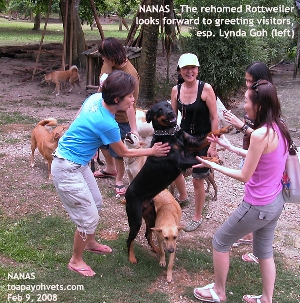 |
|
Max
loves visitors and appears to me to be
unrestricted by canine gangs |
In the dog pack, there is a hierarchy. The strongest and bravest will be the alpha dog and the others just submit to him or her. But in NANAS, most of the dogs are sterilised. Possible exceptions are the very old males and they have no strength or are they threats to the young ones.
"Food is amply provide for," Mr Raymund Wee told me. "So there is no need for the dogs to be aggressive and fight for food." I observed that the dogs were not rushing or fighting during feeding time when I visited NANAS twice and saw the feeding being done.
If not for food, how about the dominance to breed?
Yet the NANAS dogs are sterilised. So, in theory,
there should be peaceful living and all dogs can
go from one place to another. In that case, Bobby
should be able to wander anywhere when Ms Esther
Seah visited him.
Yet, this is not the case. The over 600 NANAS dogs
are territorial in my opinion. Why? There is no
need for a dominant male to fight for the females
since all females are sterilised. We presume that
there is no sexual hormone production since the
dogs are sterilised. So there should be no
out-of-bound markers inside the spacious land of
NANAS.
However, the
adrenal glands sited above the kidneys in the dog
still produces some sexual hormones and these may
explain the territorial behaviour of groups of
dogs.
It seems that groups of dogs form alliances to
protect their turf. In my opinion as no one male
dog is strong enough as his testosterone level had
been considerably reduced during neuter and
therefore there ought to be freedom for any dog to
roam. Yet is this the real situation?
Now, what is
the distance between two groups of dogs
before they will fight to protect their turf?
During my few visits, there would be the
occasional dog growling and attempt to snap at
another dog in the reception area.
The separation
between the 2 dogs would be around 2 feet and
therefore the private space of one dog must have
been invaded.
After some scolding, sometimes by Mr
Raymund Wee, the dogs behaved. Most of the
dogs at the reception area live and let live but
there will be one or two who just are domineering,
just as there will be school bullies in a school.
Yet the male dogs are neutered but some resists
invasion of their personal space at the reception
area where the top dog (Mr Wee) has his room.
How many turfs are there in a community of 700 dogs? How does a newcomer get integrated into the community? Does he get attacked by a group of dogs? Is it "every dog for himself or herself?" Do groups of dogs attack non-canine animals like racehorses when their territory is invaded? What about goats? What about geese wandering around? Do they get killed? How did Bobby fit in? Has Max free run of the land in NANAS? What happens when a new dog goes to NANAS?
"Pampered dogs like the Pekinese will not fit into the community living in NANAS," Lynda said to me when I first met her at the Yishun Swamp Land vaccinating the dogs prior to re-homing at NANAS. I had not visited NANAS and so could not quite understand what she meant. So, what type of dogs can be integrated into NANAS?
More research needs to be done. There seems to be
canine "war lords" in NANAS but how many and how
do they carve out their turf?
Any new info on
dog behaviour and how each individual dog adapts
to a new life at NANAS will
be much appreciated. Please e-mail your findings
or observations to
judy@toapayohvets.com
 TOA
PAYOH VETS
TOA
PAYOH VETS